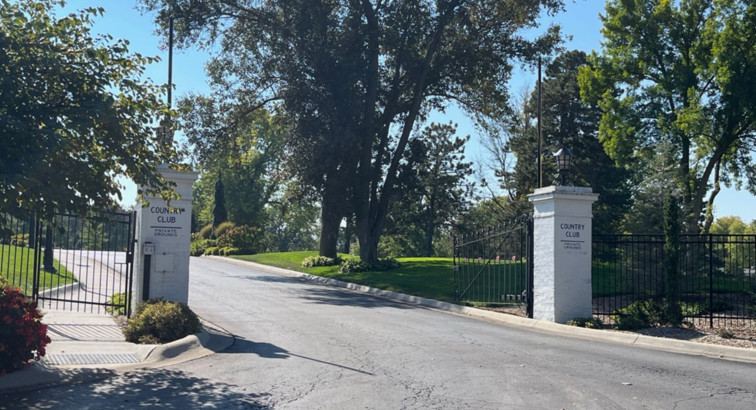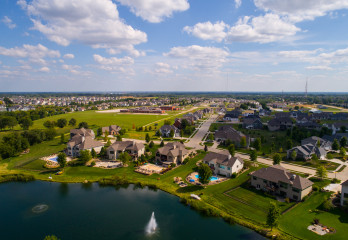The Lincoln Country Club is the product of a Golden Era.
Those who are looking for a home with class and style may want to start their search in the Country Club neighborhood of Lincoln. Many homes in this area have a unique architectural style like only the roaring 20s could produce.
A Rich History
The Country Club of Lincoln was chartered in 1903 with its original location being a home at 7th and Washington built by David Butler, Nebraska’s first Governor. The original golf course was built near a mill, causing the greens to be separated by railroad tracks in some locations. Membership took off, and it wasn’t long before club leaders began searching for a new location. The Woods brothers had a portion of land they determined had too many hills to build houses on, and Mark Woods convinced the Country Club to purchase the 65 acres in 1917 at a cost of $100,000. The golf course followed the natural terrain of the prairie and the course currently used today closely resembles the course William Tucker and Gregor MacMillan laid out in 1922.
The Country Club grounds once overlooked Page Airfield to the West. Many patrons of the golf course later recalled the possibility of a young Charles Lindbergh flying planes above them. In fact, this is probable if those patrons used the course in the spring of 1922, as Lindbergh dropped out of his engineering courses at the University of Wisconsin and began aviation training at the Lincoln Flying School, operated by Ray Page of the Lincoln Standard Aircraft Company, at Page Airfield in March of 1922. On April 9, 1922, Charles Lindbergh flew for the first time as a passenger, followed by another flight a few days later for his first formal flying lesson. Lindbergh left the Lincoln school in June to pursue his aviation career.
The Country Club flourished seeing initiation fees soar from $300 to $1,000 in 1928. A new clubhouse was finished by 1925 and new lavish homes were built around the club. Architects with a hand in the creation of the Country Club neighborhood included the popular Lincoln firm Fiske and Meginnis, who also designed the clubhouse, and landscape architect Ernst Herminghaus, designer of Pioneer’s Park and the Lincoln Capitol grounds.
Although the Country Club area experienced a mass exodus during the great depression, by 1940 memberships returned and the Country Club of Lincoln recovered, even having enough money to purchase previously leased land to the South. The Country Club once again fell into dire financial circumstances during World War II but managed to survive by actively recruiting female members and, after the war, installing slot machines in the clubhouse. These slot machines even allowed for an addition to be built onto the clubhouse in 1960. Over a century since its incorporation, the Country Club of Lincoln is still going strong.
Community Matters
.png) The Country Club neighborhood is a proud and highly involved community; this is evident by the number of events the Country Club Neighborhood Association hosts. Annually, the association organizes a May Day party at Pocras Park, a block party on 31st street, a Fourth of July parade and party on Woodsdale Boulevard, an Easter event on Sheridan Boulevard, and a Halloween event labeled “Brews and Stews” before trick-or-treating commences. They have also hosted swimming parties at Irvingdale Pool and a “Neighborhood Night” at Haymarket Park to watch the minor league Lincoln Saltdogs baseball team. In addition, the Country Club Neighborhood Association provides a welcome packet to new residents with information about the Association, the neighborhood, and local businesses.
The Country Club neighborhood is a proud and highly involved community; this is evident by the number of events the Country Club Neighborhood Association hosts. Annually, the association organizes a May Day party at Pocras Park, a block party on 31st street, a Fourth of July parade and party on Woodsdale Boulevard, an Easter event on Sheridan Boulevard, and a Halloween event labeled “Brews and Stews” before trick-or-treating commences. They have also hosted swimming parties at Irvingdale Pool and a “Neighborhood Night” at Haymarket Park to watch the minor league Lincoln Saltdogs baseball team. In addition, the Country Club Neighborhood Association provides a welcome packet to new residents with information about the Association, the neighborhood, and local businesses.
Elementary Schools in the Country Club neighborhood include Beattie Elementary, Prescott Elementary, Rousseau Elementary, and Sheridan Elementary. Irving Middle School, named for Washington Irving who authored such literary works as Rip Van Winkle and Legend of Sleepy Hollow, has an outstanding reputation and serves as the neighborhood’s middle school. For high school, part of the neighborhood falls in Lincoln High’s district and part in Southeast High’s district. Lincoln High is Lincoln’s first high school, founded in 1871. Its current building was built in 1915 and has had major additions five times since opening. Lincoln Southeast High School opened in 1955 and is a highly-rated high school with a long-standing legacy of educational excellence. While these are district-assigned schools, Lincoln Public Schools have an open enrollment policy, subject to space and availability.
A Well Established Neighborhood
.png) The Country Club Neighborhood in Lincoln, Nebraska is a well-established neighborhood with unique architecture and landscaping. More than 60 percent of homes in this neighborhood were built prior to 1939. Currently, the median price for real estate in the neighborhood is $360,000 and nearly all real estate is owner-occupied. Almost 38 percent of homeowners in the Country Club area have a Masters's degree, medical degree, Ph.D., or law degree and nearly 70 percent make their living as an Executive, a manager, or other professional.
The Country Club Neighborhood in Lincoln, Nebraska is a well-established neighborhood with unique architecture and landscaping. More than 60 percent of homes in this neighborhood were built prior to 1939. Currently, the median price for real estate in the neighborhood is $360,000 and nearly all real estate is owner-occupied. Almost 38 percent of homeowners in the Country Club area have a Masters's degree, medical degree, Ph.D., or law degree and nearly 70 percent make their living as an Executive, a manager, or other professional.
Your Next Home
If you like antique architecture and a close-knit community, the Country Club neighborhood in Lincoln is the perfect area to search for your next home. The Country Club golf course offers an extra incentive for golfers and the nearby boutique stores and restaurants are within walking distance. The average commute time to work is less than 15 minutes and more Country Club residents are choosing to cycle to work than ever before!
If you are interested in finding a new home in the Country Club neighborhood in Lincoln, Nebraska contact a Nebraska Realty agent to discuss your options!
Article by TJ Chrastil
(Resource Material for this article includes an article by Julie Enerson titled “The Country Club of Lincoln” in the Fall 2003 edition of the Country Club Neighborhood Association’s publication “The Chronicle,” Wikipedia, Lincoln Public School’s website, neighborhoodScout.com, the Country Club Neighborhood Association’s website and a blog on History.Nebraska.gov titled “Nebraska was once a leader in the U.S. Aviation History.”)



